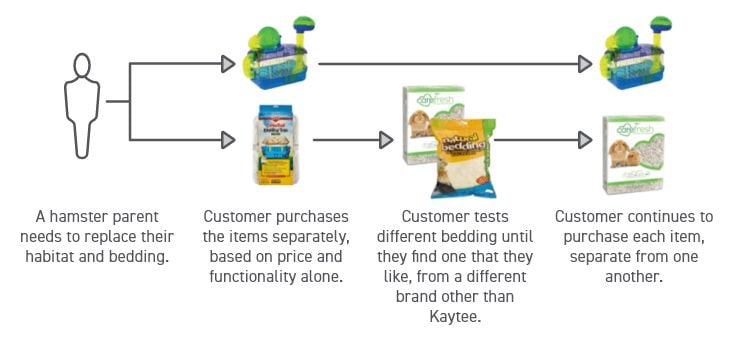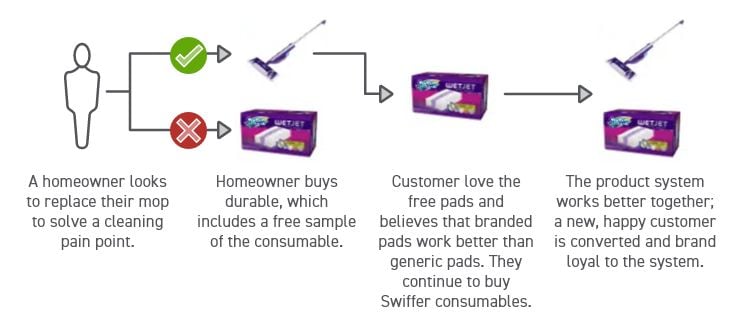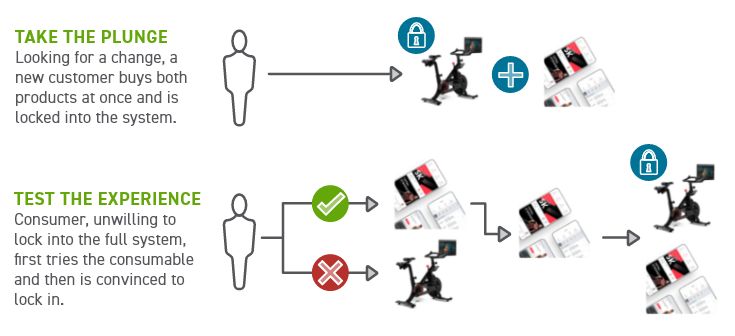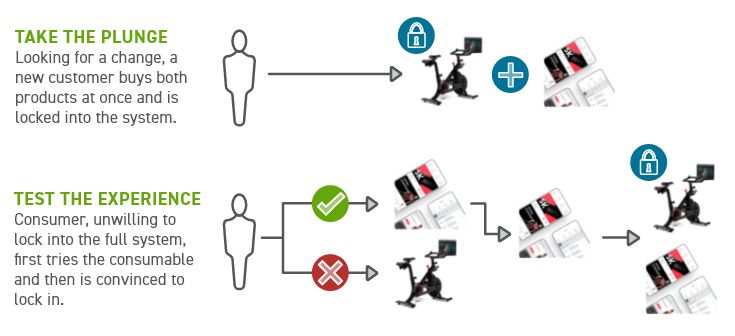Contributors: Andrew Topinka, Francesco Fazio, Travis Sheldon
When approaching product innovation, businesses can see increased revenue and market share by designing a superior product system, rather than focusing solely on superior product performance.
In a viability study for a cat litter brand, Cherry Bekaert assessed the financial impact of introducing a cat litter box to the brand’s consumable-only portfolio. We found that the addition of the litter box, a durable product, would bring in $100 million in additional revenue—two times the revenue of the brand’s current model of selling only cat litter, a consumable product.
While the litter box would only be purchased by customers once, offering the co-branded litter would unlock superior value to the customer and drive recurring revenue for our client.
Cherry Bekaert’s Strategic Growth & Innovation team helps organizations around the world capture greater market share and keep consumers coming back for more. We can help you design a product system that will be the next great analog for others to study, as seen in the examples below.
Creating Value with Product Systems
Product systems are a set of products, usually two, and/or services that provide greater value together than individually. These products are either consumable, meaning they have an intentionally short lifespan and are replaced routinely, or durable, meaning they have a long lifespan and rarely need to be replaced.
Consumable-durable product systems capture long-term customer value because ownership of the durable drives routine purchases of the consumable. Although product systems may require a greater initial investment, they have the potential to attract new customers, capture greater share of wallet spend with existing customers, and drive loyalty and repeat purchasing.
Consumable-durable Product Systems Work. Cherry Bekaert studied 35 analogous organizations (analogs) to understand how they have captured long-term customer value with their product systems. We researched brands like:
- Swiffer, the durable sweeper that never needs to be replaced, and the consumable pads that are tossed and replaced after mopping a floor.
- Amazon’s Kindle, the never-changing durable tablet and the ever-changing, consumable e-books on it.
- Quip, the durable toothbrush handle and the consumable replacement brushes that are automatically replenished to guide brushing behavior.
Through our research, we gained a greater understanding of consumer behavior and identified how brands can tailor their product systems to achieve the growth levers that best suit their strategy.
The Four Winning Archetypes for Product Systems
Our research unveiled four common archetypes that offer guidance into what makes a successful consumable-durable product system. The archetypes organized around the “openness” of the systems; open systems allow products within the system to work with other brands, while closed systems only work with products within the brand.
Archetype One: Mix & Match
Mix & match systems allow both the durable and consumable to work with other brands. This is an attractive option for consumers who are less willing to commit to one brand, and they will typically “mix and match” products across the system. There are three characteristics of this archetype:
- Commoditized products, which focus on their functionality meeting market parity, as it is difficult to differentiate one or both parts of the system across competition. This results in many options being available, and consumers consider all options.
- Purchase autonomy, which allows consumers to test out new consumables and durables constantly. Consumers may be brand loyal to a durable product that offers superior performance, but not associate that loyalty to the consumable product.
- Strong marketing, which maximizes shelf space for in-store purchases and implements strong SEO for online purchases. Consumers never fully anchor to a specific brand or product and are influenced by price and convenience.
The brand Kaytee provides one example of a mix & match system.
Kaytee is a worldwide supplier of hay, foods and care products for pet birds and small animals. It captures new customers by dominating shelf space in-store and by implementing heavy online advertising. Consumers will buy the habitat (durable) once, and frequently test different bedding (consumable) brands until they find a product they like, whether out of convenience or due to price.
Here is what the consumer journey looks like:

Archetype Two: Brand-Match Open
Brand-match open is either a fully or partially open system, but consumers tend to stay loyal to the brand, often because they think it’s a closed system. The three features of this archetype are:
- Entry or anchor products, which are typically market-differentiated solutions that solve a deep consumer pain point. In open systems, consumers are disproportionately likely to show loyalty to the entry product.
- Open systems, closed behaviors, meaning strong alternatives exist for the non-entry product, but consumers stay loyal to a brand and don’t consider other options because of free trials and brand marketing.
- Expressive vs. utility brands: expressive brands tend to extract a greater share of wallet from their customers through community and identity, whereas utilitarian brands must compete on performance, and thus utilize brand-matching to gain an advantage.
Brand-Match Open Example: Swiffer
 \
\
This example illustrates brand match when the durable product drives entry. Swiffer acquires new customers with a superior durable product that solves a pain point. This anchors customers to the brand with a positive product experience.
With the utilization of strong branding and a trial for the consumable product – free pads with your purchase of a mop – consumers may not be aware that this is an open system. This convinces consumers to pay a premium for the consumable.
Although the Swiffer-branded consumable pads are up to seven times more expensive than the generic alternative, Swiffer has achieved 36 times more product reviews on Amazon, which has likely driven sales by extension.
Archetype Three: Closed Optional
This product system typically includes a closed durable, or a product that will only work with the same brand of consumable, and an open consumable that can be used with any brand of durable. Typical features of closed optional systems are:
- Reducing barriers to entry, by offering a trial or sample versions of the system and allowing consumers to inch their way into a closed system instead of jumping headfirst.
- Offering flexibility, not superiority by giving customers the opportunity to experience a part of the closed system with the consumable to get a small taste of the full experience and what the full system could provide to them.
- Correlating price to customer acquisition because consumers have a feeling that there’s ‘no going back’ once they make a purchase and opt-in to a closed system. The higher the price of a system, the more difficult it is to acquire customers.
Closed Optional in Action: Peloton


Peloton customers can choose to purchase the bike (durable) and the subscription (consumable) together, to unlock the full value. Consumers that are apprehensive to lock themselves into the full system typically test the consumable first until they are convinced to purchase the full system. By allowing access to only the consumable, customers’ barrier to entry is reduced.
Peloton has 625,000+ paying, digital-only subscribers, with a 10% conversion rate to purchasing the hardware. With a 93% retention rate on new bike-buying customers, it has managed to capture $8.2 million in annual revenue by including a digital-only model.
Archetype Four: Closed Lock
The ultimate closed system occurs when consumers have no choice but to purchase both the consumable and durable product if they want to utilize either of the products in the system. Neither component of the system can be used with a different brand.
Characteristics of a closed lock system are:
- Products are useless without each other, and you are unable to extract value from only one piece of a closed-lock system.
- Customer loyalty with predictable recurring revenue.
- Products are launched together.
Closed Lock in Action: WHOOP
WHOOP offers differentiated value in the combined system, targeting a specific niche audience. The wearable health & fitness tracker (durable) is useless without the corresponding app (consumable), and vice versa. Locking customers into the system improves retention and recurring revenue. To incentivize an initial purchase, WHOOP gives away the durable, instead baking the cost into the consumable prices to ultimately capture greater lifetime value than competitors.
Proof that it works: Some simple, back-of-the-napkin math, shows that the WHOOP system could capture $864 per customer over three years with its $24 per month plan, as opposed to $399 every three years for the Apple Watch
Key Insights from The Archetypes
These archetypes highlight exciting, product-centric approaches to innovation that your organization might choose to adopt. But, how do you know which one is best positioned for your company and products?
While researching these brands and how they chose to build systems in an archetype, we found themes in their business objectives and customer preferences. Swiffer, for example, likely had the business objective of acquiring customers from other companies when it decided to leave the system more open and offer a low-risk way for customers to test out a new product. Whoop, on the other hand, likely saw that fitness consumers prefer subscription models (for their workout classes, etc.) and knew they could capitalize on that preference with a closed system.
Be clear and thoughtful about how you want to grow and who you want to target, then design your product system accordingly. Cherry Bekeart’s Strategic Growth & Innovation team is here to help every step of the way.
Sources:
Swiffer. https://www.swiffer.com/en-us/. May 2022.
Kaytee. https://www.kaytee.com/. May 2022.
WHOOP. https://www.whoop.com/us/en/. May 2022.
Peleton. https://www.onepeloton.com/. May 2022.




